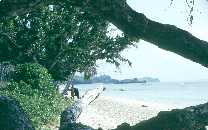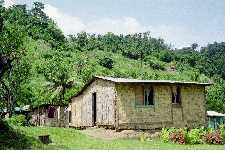
It was the rising sun shining through the porthole that caught my
attention. It was projected onto the cabin wall, a reddish ball of fire,
shimmering, and seemingly growing larger by the minute. So calm was the sea that
it appeared virtually stationary but then moved slightly as our cruise ship
moved on the sea. Suddenly there was the rattle of the anchor. We had arrived
in Manunggila bay off one of the remotest of the islands in the Yasawa group.
This tropical paradise in the South Pacific, near to the equator, is part
of the Fijian group. The customs and culture in Fiji to the east are Polynesian
but this village was home to 140 Melanesians, the only occupants of this remote
island.
Estimates of anthropologists suggest that their ancestry can be traced back
to Indonesia and South East Asia. Their navigational skills together with the
constant westerly winds enabled them to explore over thousands of miles of the
Pacific Ocean. The physical attributes necessary to achieve these feats are
reflected in the sturdy people of today. What made them strike out into the
unknown in the hope of finding land? They could not have forecast this blissful
tranquillity. In fact their history was not a peaceful one until the islands
were ceded to the British in 1874.
Passengers were ferried ashore by the ship's tender. Already the crew had
been at work transferring the equipment needed for a beach barbecue. We had
ceased to be amazed at the quantity of food on offer and the unfailing courtesy
of the staff. We were cautioned to leave the island in the same condition as we
found it - a small enough request considering the havoc that the full complement
of passengers could cause. We sat near the beach under the shade of a
broad-leafed tree. The sun was so strong that the shade was as important as our
shadows were short.
"A cerulean sea," said our companion. Since he was a lecturer in
fine art we did not argue whether it was more turquoise than blue.
|

Under our tree a form of ground creeper grew out of the sand and formed
matting to sit on. The palm trees filtered the sun's rays slightly and if the
cirrus clouds reduced the sun's strength we were not aware of it. Further along
the beach the palm trees reached to the water; their slender leaves too high and
sparse to provide the protection we needed.
Way out in the bay we could see our cruise ship. We had been ferried by the
lifeboat to a small jetty floating on oil drums by the shore; the only intrusion
of modern civilisation into that glimpse of unspoilt nature. Pieces of coral had
been washed up onto the beach; twiglets of white standing in the sand. A cooling
breeze encouraged light surf and at the waters edge a mixture of coral and sand,
broken down over the centuries, was sharp on the feet. Nevertheless the tepid
water invited a swim in the clear sea. The wave action had steepened the descent
of the beach but then it rose up to a plateau before the deeper waters beyond.
There were of course dangers to swimming in those parts. Not from the
sharks, which patrolled the deeper waters, but from the sun which penetrated the
water as we swam. If we stood to chat it would burn our shoulders where the sun
cream had been washed away. We swam on our back as much as our front, and
rationed our time to fifteen minutes.
Organising a barbecue for about 500 people was evidently routine - with a
complement of chefs capable of feeding up to 800 people. A thatched roof
protected the cold drinks and buckets of cooling ice. A variety of fish and meat
was served, evidently from a barbecue production line. Salads and rolls were to
be had at the adjacent stalls. The gateaux and ice cream were discreetly placed
on one side in order, no doubt, to prevent temptation at too early a stage in
the meal. The reader might ask whether such a repast would spoil the idea of
paradise away from the temptations and distractions of the western world. I have
to admit that it did not, and I was able to separate my thoughts from those
higher ideals long enough to enjoy the meal.
Behind, in the trees, the native Melanesians had laid out their wares on
mats for our inspection. Woodcarvings and polished shells were predominant; some
made into intricate and colourful necklaces. A magnificent belt made of shells
by a Fijian woman was offered for sale for five Fijian dollars (equivalent to
about three pounds). The woven baskets and mats were typical of other islands we
had visited earlier. They were made from the leaf of the pandanus tree.
Some 100 metres along the shore lay the village. The houses, made of woven
bamboo and a thatched roof, were cool and matting lined the floor. The
accommodation consisted of a communal room; sometimes with sections curtained
off with the bamboo or woven matting. The village was shaded by palm trees; some
bearing coconuts; alongside were plots for vegetables. The beach was but 50
metres away with an abundance of fish and nearby we could hear the familiar
melodic song of the Melanesian people accompanied by guitars. It appeared to be
a very relaxed and peaceful way of life. My wife thought she would like to stay
there.
As the shadows lengthened at the end of the day we returned, reluctantly to
our ship and soon the island was left to itself, its palm trees, and its
Melanesian people.
|



